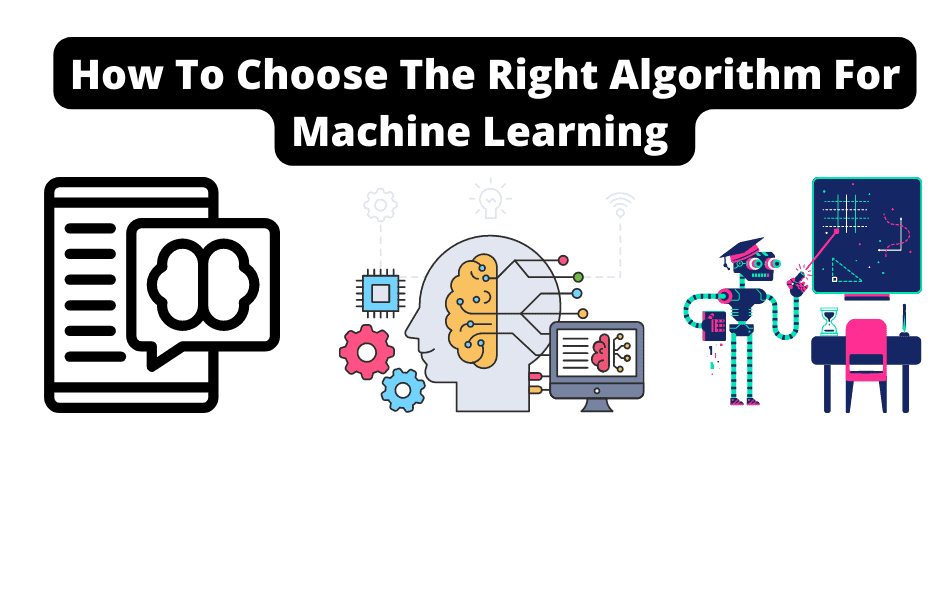I’ll be honest; choosing the right algorithm for machine learning can be one of the most challenging parts of our jobs.
Don’t worry; we’re here to help.
In this article, we’ll be breaking down the process of selecting the perfect algorithm for your project in a simple but effective easy-to-understand way.
We’ll start by taking a high-level look at the world of machine learning algorithms and what to consider before you even touch that keyboard.
Then, we’ll review critical considerations and KPIs to help you know you’ve made the right choice.
By the end of this article, you’ll have a solid understanding of what to look for when choosing a machine learning algorithm and feel confident in your ability to make the best choice for your project.
If you want a future in this field, this is a MUST-READ.

The Two Main Pillars of Machine Learning
Regarding machine learning, there are two main pillars:
Unsupervised learning and Supervised learning. Understanding these two distinct pillars is critical in choosing the right algorithm for your project.
Unsupervised learning is a type of machine learning where the algorithm is trained on a dataset without any specific target variable.
The algorithm must then find patterns and relationships within the data on its own.
This approach is used when you don’t have a target variable or are interested in clusters and groups within your data that aren’t extremely obvious.
For example, an unsupervised approach is excellent when looking for marketing groups and segments within a customer base to increase sales.
Conversely, supervised learning is a type of machine learning where the algorithm is trained on a labeled dataset with a particular target variable.
This means the algorithm knows what it’s trying to both predict and improve on, allowing our algorithm a path to convergence.
Supervised learning is often preferred over unsupervised learning simply due to the information gain.

Let’s run through an example.
Say you have four columns of data and a “target variable.” Since our unsupervised algorithm does not use this target variable, it will take advantage of the four columns.
On the inverse, our supervised algorithm will have four columns of data plus the target variable.
This means our supervised algorithm will have nearly 25% more data to work with!
It’s important to note that your dataset and problem usually dictate which machine learning pillar you should use.
Remember, it’s best to utilize supervised algorithms whenever possible, as they provide more information and can help you achieve better results.
In summary, the two main pillars of machine learning are unsupervised and supervised learning.
While unsupervised learning helps uncover hidden patterns in data, supervised learning is preferred because it can converge on a target variable and provide the underlying algorithms with more information.
One Pillar Has Two Categories; The Other Has None
Under the umbrella of supervised learning, there are two main categories: regression and classification.
Regression is a type of supervised learning where the target variable is continuous, meaning it can take on any value within a range (Note, that range can be 0 to infinity)
The algorithm is trained to predict the target variable’s value based on the input variables’ values.
For example, using historical data on housing prices and their respective features, a regression algorithm can predict the price of a future house based on its features.

On the other hand, classification is a type of supervised learning where the target variable is categorical, meaning it can only take on a limited number of values or categories.
The algorithm is trained to predict the target variable’s category based on the input variables’ values.
For example, one of the most classical machine learning problems is when using data on flower species and their respective features; a classification algorithm can predict the species of a flower based on its features.
It’s worth noting that these two categories only exist in supervised learning, as we have a target variable to learn from and optimize for.
This allows us to predict future values or groups based on the information we’ve learned from the target variable.
In unsupervised learning, we don’t have a target variable to tell us if we’re doing a good job with our predictions.
Our algorithms have nothing to optimize for; they only find patterns and relationships within the data.
This means unsupervised learning differs from supervised learning, requiring an almost different philosophical approach to choosing an algorithm.
What To Do Before You Start Coding Your Algorithm
Before you start coding your machine learning algorithm, sit down and ensure you understand your business problem and are being realistic with your data.
This will help you choose the correct algorithm for your project and ensure you get the best possible results.
When it comes to understanding your business problem, it’s essential to determine whether you’re trying to optimize toward a target (supervised learning) or looking for a new way to look at your data (unsupervised learning).
For example, if you’re trying to predict future sales or which group a new member would belong to, you’ll need a target variable, and supervised learning would be the best approach.
On the other hand, unsupervised learning would be the better option if you’re looking to build up groups and clusters without guiding the algorithm.
Be realistic with your data.
Supervised algorithms are immediately not an option if you don’t have a target variable.

In this case, unsupervised learning is the only option available.
In summary, before you start coding your machine learning algorithm, understand your business problem and be realistic with your data.
Use your data as a guiding light, and make sure you choose the right approach based on your specific needs and the information available.
Quick Guide To Choosing The Right Machine Learning Algorithm
Here’s a quick mental map that I use to choose the right algorithm.
Understand your business problem: What are you trying to solve?
Understanding your business problem is the first step in choosing the right algorithm.
Before exploring different algorithms, you need to understand what you’re trying to achieve.
Explore your data: What columns and data do you have that’s usable?
You need to have a good understanding of the data you have available to you.
This will help you choose an algorithm that is well-suited to your specific needs and can take advantage of the data you have.
Determine if it’s a supervised or unsupervised problem: Once you have explored your data, you need to figure out if you’re dealing with a supervised or unsupervised problem.
This will help you narrow your options and choose the right approach for your problem.
Determine if it’s regression or classification: If it’s a supervised problem, you need to figure out if it’s regression or classification.
Are you predicting a continuous value or putting things into predetermined categories?
Find a group of algorithms to test: Use what you now know about your problem to find a group of algorithms within your group (such as supervised regression or unsupervised NLP problems).
This will help you narrow your options and find the right algorithm for your needs.
Note: As you’ve noticed, we say to find the group independently, as we have yet to recommend any specific data science algorithms.
Finding the right machine-learning model is an iterative process.
Anyone suggesting “regression trees are best when doing X” does not understand machine learning and how algorithms work.
Assess each algorithm in the group: Test each algorithm in the group and assess its performance.
This will help you determine which algorithm performed the best and is the best choice for your specific problem.
Select the machine learning algorithm: Based on your results, select the machine learning algorithm that best suits your business problem.
This will be the algorithm you use to solve your problem and achieve your goals.

What To Watch Out For When Choosing Your Algorithm
When choosing a machine learning algorithm, there are several things to remember when picking out that perfect algorithm.
First, don’t fall in love with an approach before it’s tested.
Even if a particular algorithm looks good on paper or has worked well for others, it may not work the same for you.
It’s important to test multiple algorithms and compare their results to find the best one for your business needs.
Second, remember that your data and problem choose the algorithm, not you.
You may have a favorite algorithm you’re excited to use, but it’s not the right choice if it doesn’t fit your data and problem well.
Make sure to choose an algorithm that is well-suited to accomplish your goals!
Third, be aware that all algorithms seem good before they’re tested.
Only after testing will you know how well an algorithm will perform on your problem.
Don’t be swayed by an algorithm’s hype or popularity- test it and compare its results to other algorithms.
Fourth, don’t assume that a higher accuracy means a better algorithm.
While accuracy is important, it’s not the only factor to consider.
Other factors such as speed, interpretability, and scalability also play a role in determining the best algorithm for your needs.
Fifth, ensure your data source is “tapped,” meaning you can’t get any more data.
If you can obtain additional data, you can improve the performance of your algorithm or choose an altogether different algorithm that could perform much better (remember our unsupervised vs. supervised talk above).
Finally, remember that sometimes the best answer is the most straightforward answer.
Don’t get caught up in using complex algorithms just to use a complex algorithm.
The simplest solution is often the best, especially if it provides the desired results with a lower risk of overfitting or over-complication.
How To Know You’ve Picked you’ve chosen the right learning model for your problem.
Ultimately, the best way to know if you’ve picked the right machine learning algorithm for your problem is if you’ve successfully solved the problem you initially set out to solve.
If your algorithm provides the desired results and you can achieve your goals, you’ve likely made the right choice.
On the other hand, if your algorithm is not providing the results you need, it’s time to go back and reassess.
It’s important to remember that machine learning algorithms are not one-size-fits-all solutions.
What works well for one problem may not work well for another.
This is why it’s important to test multiple algorithms and choose the best fit for your needs.

- Debug CI/CD GitLab: Fixes for Your Jobs And Pipelines in Gitlab - July 1, 2025
- Why We Disable Swap For Kubernetes [Only In Linux??] - July 1, 2025
- Heuristic Algorithm vs Machine Learning [Well, It’s Complicated] - June 30, 2025

